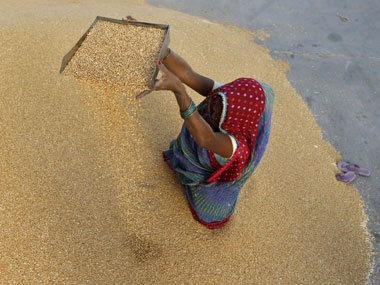Bhopal: It has to be either a major miracle or a massive hoax. Whatever it is, Madhya Pradesh’s agricultural mathematics could confound the best of brains. Under Shivraj Singh Chouhan, the state appears to have scripted a spectacular success story in agriculture — it is counted among the top wheat producers in the country now and it has won the President’s ‘Krishi Karman’ award for best agriculture production twice in succession. The turnaround in the farm sector in the state was one of the major talking points in the general elections a few months ago. [caption id=“attachment_1611119” align=“alignleft” width=“380”]  Representational image. Reuters[/caption] In 2008, the state’s wheat contribution to the central pool was 50,000 tonnes; in 2011, it went up to a whopping 47 lakh tonnes. In 2012, government agencies expected the yield to be 18 quintal per acre, but the farmers hit the 26-quintal mark, an impressive 30 percent more. Too good to be true? The simple questions everyone should be asking the government is ‘How?’ But its claims have escaped all scrutiny so far. It now appears the agricultural growth story is riddled with tales of corruption and fudged figures. Two years ago a state-sponsored advertisement claimed the procurement bonus during the Congress rule in 1993-2003 was Rs 21 crore. It rose over 86 times to Rs 1,820 crore in 2012 under the BJP. Farmers from the neighbouring states like Gujarat, Maharashtra and Uttar Pradesh are bringing in their produce to the Madhya Pradesh markets, lured by the bonus of Rs 140 to 150 per quintal over the Minimum Support Price (MSP). It has led to a big jump in procurement. The bonus is meant to be paid only to state farmers. Outsiders bribe their way through the system to transport grains from the nearby states. Madhya Pradesh relies on a completely computerised “e-procurement” system — from registration of farmers to depositing payments in their bank accounts. However, the system is not foolproof. Farmers inflate the output. There are instances of the government having bought wheat from ghost farmers. The bonus did encourage state farmers to increase wheat acreage. “Wheat area has been increasing steadily. We have already crossed the targeted area of 4.95 million hectares,” says MM Upadhyay, state Agriculture Production Commissioner. However, that does not quite explain the massive jump in output. The state crossed the targeted area of 4.95 million hectares 2012-13 to reach over 5.2 million hectares and in 2013-14 it hit 5.7 million hectares. However, with 49 out 51 districts reporting a loss of 25 to 50 per cent crops the staggering production astounded everyone. A former state director of Agriculture who did not like to be named says the government needs to crosscheck its claims. The production rising so high even after such losses is incredible. The state produced 132 lakh metric tonnes of wheat in 2011-12. The next year it rose to 161 lakh metric tonnes and this year it is expected to be in the range of 174 and 178lakh metric tonnes despite extensive damage to the crops due to hail storms and unseasonal rain. At least ten farmers had committed suicide after hailstorm and rain ruined crops in 26,000 out of the state’s 52,000 villages. The state had paid compensation to more than 3 million farmers. The calamity struck just when the high pitch election campaign was at its peak. Chief Minister Shivraj Singh Chouhan, who is a farmer with substantial land holding besides being a shrewd politician, made the most of the crisis by announcing a Rs 2000 crore compensation to the farmers and lobbed the ball in the Centre’s court by demanding over Rs 5,000 crore compensation package. Even while wallowing in self-pity over heavy losses the state raised its wheat output 10 percent and persisted with the demand for compensation from friendly NDA government at the Centre. Though wheat acreage was 10 percent higher this year the state apparently overstated the losses or inflated the production. The happy farmers naturally sided with the BJP. The other scandal involved the disappearance of several lakh quintals of the procured wheat. The agriculture co-operative societies made payments apparently to ghost farmers but wheat purchased from them did not reach the warehouses. The modus operandi was simple. Cooperative societies made fake purchases. Money was drawn from banks against these purchases. Cash was siphoned off in the name of non-existing farmers and routed to cooperative society officials and banks, which ran huge losses. The societies invented ideas to explain the disappearance of wheat. A manager at Ujjain is reported to have explained the loss of 10,000 quintals to loss of moisture between weighing.
It has to be either a major miracle or a massive hoax. Whatever it is, Madhya Pradesh’s agricultural mathematics could confound the best of brains.
Advertisement
End of Article


)

)
)
)
)
)
)
)
)



